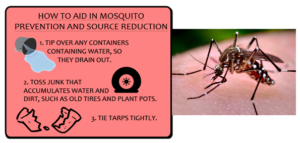The Zika virus is a disease that is transmitted through one of Guam’s most common pests – mosquitoes, particularly mosquitoes of the Aedes genus, and mainly Aedes aegypti in tropical regions. This is the same mosquito that transmits dengue, chikungunya and yellow fever.
The disease can also be transmitted through sexual intercourse from a man to his sexual partners, and symptoms include fever, rash, conjunctivitis (red eyes), muscle and joint pain, and headache. Researchers have linked the virus to miscarriages and microcephaly in pregnant women. Microcephaly is a serious birth defect in which a baby’s head is too small, resulting in incomplete brain development.
While there have been no deaths linked to Zika, and no known cases on Guam, there is currently no effective vaccine against the disease.
The newly erected mosquito lab by the Division of Environmental Health of the Department of Public Health and Social Services may be Guam’s chance against such a threat.
The lab was constructed under the consultation of the Center for Disease Control. The CDC helped in terms of design and equipment deemed necessary for the facility.
Rosanna Rabago and Claire Baradi, both alums of the University of Guam and officers at the island’s Division of Environmental Health under the Department of Public Health and Social Services, shared the lab’s mission and goals for the future.
“We are not at full capacity, so we are doing operations we are capable of,” Rabago said.
The primary objective of the new lab is to carry out preventative measures, such as surveillance, sorting and identifying mosquito species, pesticide resistance, and PCR, which is a polymerase chain reaction – a way of identifying pathogens through genomes.
“Our main focus is surveying and identifying mosquitoes and mosquito-borne viruses, such as Zika,” Baradi said. “We aim to be the sentinel lab for the region, but that will take years.”
According to Baradi, the main way to combat the threat is through prevention and source reduction. This can be done by destroying larvae, clearing and maintaining clean waterways, and eliminating standing water.
“We’re glad someone is doing an article like this because educating the public about this kind of thing is difficult,” Rabago said.
Since Guam can only do so much with the resources and facilities available, it is forced to look to prevention efforts in the mainland.
Recently, the Obama Administration requested $1.9 billion from Congress to aid in combating the Zika outbreak. However, since it is an election year, Congress is not likely to make a hasty decision. In response to Congress’s slow response, the White House as relocated $500 million from funding to fight Ebola to efforts against Zika.
The Zika virus has left a trail starting from Brazil in April of 2015 and making its way through South America, Central America, Mexico and the Caribbean. The World Health Organization estimates that the virus is going to spread through most of the Americas by the end of 2016.
Travel warnings have been implemented in multiple countries, and several of those countries have warned their citizens to avoid getting pregnant until the virus is analyzed.


